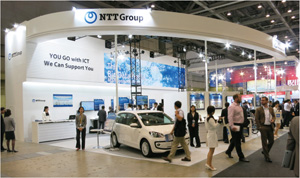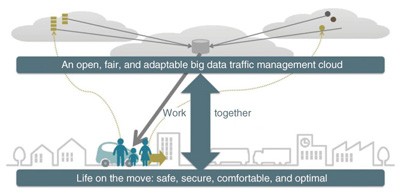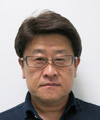 |
|||||
|
|
|||||
|
Global Standardization Activities Vol. 12, No. 5, pp. 62–66, May 2014. https://doi.org/10.53829/ntr201405gls NTT Group’s Involvement in ITS, and the Direction of StandardizationAbstractIn 2013, the ITS (Intelligent Transport Systems) World Congress event returned to Japan for the first time in nine years. NTT participated in this event, and we based our exhibit on the key concept that all mobile objects should function as network terminals that are continuously connected to the cloud. This article introduces the contents of NTT’s exhibit, discusses the information and communication technology needed to realize our vision of “2020: Life on the Move,” and reports on the direction in which the future efforts of the NTT Group should be steered. Keywords: ITS, ICT, cloud 1. IntroductionThe Intelligent Transport Systems (ITS) initiative aims to use information and communication technology (ICT) to achieve increased efficiency and comfort in the transport field. This initiative is now entering a new stage with the nationwide expansion of technologies such as VICS (Vehicle Information and Communication System) and ETC (electronic toll collection), and the spreading use of car navigation systems. Amid growing interest in technologies such as smartphones, car navigation systems with communication functions, so-called connected cars (vehicles equipped with their own communication functions), and self-driving vehicles, the roles of telecommunications providers are becoming increasingly prominent and important. 2. NTT Group’s view of the ITS conceptOn the basis of our vision, “2020: Life on the Move,” we formulated the concept that all mobile objects should function as network terminals that are continuously connected to the cloud (Fig. 1). This concept focuses on the applications on the network side to which smartphones and connected cars are connected, and is aimed at the total provision of services including processing large quantities of data on a cloud computing platform, and managing large volumes of traffic. In particular, it could be said that the management of data traffic, which will continue to increase in the future, is precisely a technical field in which NTT has exhibited considerable expertise as a telecommunications carrier. Based on this idea, the NTT Group’s presentations were themed around the slogan “YOU GO with ICT. We Can Support You” to indicate the fusion of ICT and mobile living while bearing in mind the ongoing selection of Next Value Partners, even in the traffic sector, through ICT.
3. Exhibiting at the ITS World CongressThe ITS World Congress is a unique international event held in a different country each year by a consortium of ITS organizations representing three regions of the world — Europe (ERTICO), North America (ITS America), and Asia-Pacific (ITS Japan). Its purpose is to create business and find solutions to the issues that face information societies as ITS becomes more widespread. To achieve this, it supports the exchange of information from a wide range of viewpoints on not only technologies but also government policies and market trends. At the 2013 congress, which was held in Tokyo, events such as symposiums, presentations, and showcases were held based on the theme “Open ITS to the Next,” and the NTT Group presented technologies and services aimed at making “life on the move” safe, secure, comfortable, and optimal. Five companies in the NTT Group (NTT DOCOMO, NTT DATA, NTT COMWARE, NTT Geospace, and Nippon Car Solutions) exhibited services and technologies supporting current mobile systems, NTT’s laboratories (five laboratories of three laboratory groups) exhibited technologies supporting future mobile systems, and NTT Research and Development Planning Department exhibited a concept video of the ITS of the future (Photo 1).
One of the technologies that attracted the attention of visitors to the exhibition was the millimeter-wave camera that is capable of finding obstacles on the road even under conditions of poor visibility such as fog or snow (Fig. 2). This was exhibited as the result of a joint study by NTT Photonics Laboratories and Nissan Research Center. At NTT Photonics Laboratories, we have been conducting research into technologies that handle radio waves at even higher frequencies than those conventionally referred to as millimeter waves. Millimeter waves in the 140-GHz band are particularly good at penetrating through fog, snow, and the like, and it is even possible to detect millimeter waves emitted naturally by people and obstacles in poor weather conditions where visibility is impaired. At the ITS World Congress, we demonstrated a system capable of tracking and sensing an obstacle represented by a model of a deer moving on rails. This demonstration system was still able to function when visible light had been blocked out by an opaque screen representing the effects of snow. The system received an enthusiastic reception from visitors to the exhibition, several of whom asked us to develop the system for practical applications. This millimeter-wave technology originated from pioneering research into devices for wireless communications. It demonstrates that the NTT Group’s technical expertise cultivated over many years in the core areas of ICT can contribute to innovation in ITS, which departs somewhat from NTT Group’s usual field of expertise.
4. ITS standardization systemIn the ITS field, the International Organization for Standardization/Technical Committee 204 (ISO/TC204) plays a central role in international standardization, and from Japan, the Japanese Industrial Standards Committee (JISC) is participating with the approval of Japan’s cabinet [1], [2]. In Japan, an ITS standards committee has been set up in offices at the Society of Automotive Engineers of Japan (JSAE) (Fig. 3), and is working on issues to be covered by ISO/TC204. Underneath the ITS standards committee there is a technical committee, and below that are subcommittees that deliberate on the actual standards proposals and liaise with international WGs (Working Groups). These subcommittees are promoted by organizations such as JSAE, the Universal Traffic Management Systems (UTMS) Society, the Japan Electronics and Information Technology Industries Association (JEITA), and the Highway Industry Development Organization (HIDO), which serve as secretariats. The discussions at these subcommittees contribute to various standardization efforts such as the specifications of map data and vehicle-to-vehicle/road-to-vehicle communication, cruise control system interfaces, and traffic management systems.
5. Future direction of the NTT GroupWhile progress is being made in standardization by manufacturers and industry groups, the theme of the Tokyo ITS World Congress was “Open ITS to the Next,” highlighting the issue that the systems of each manufacturer do not necessarily possess the interoperability needed to retain customers. We are approaching standardization in an open, fair, and adaptable way so as to provide users with services that are capable of working together. We believe this approach will go a long way towards increasing Japan’s international competitiveness (Fig. 4). By cultivating and expanding cloud services and new services using big data to create a bigger pie to share across the entire industry, we believe that it will become more important to request the circulation and utilization of data beyond the frameworks of individual businesses. While the use of big data is attracting interest, it is also rumored that businesses are unwittingly running the risk of harming their reputations through handling of personal data. The NTT Group can mitigate this risk because it operates independently of the systems currently in use by the automotive industry, and it has the experience and technology to be able to handle large amounts of data reliably and securely. As a standard-bearer for the ICT industry, it is essential that we implement our concept of 2020: Life on the Move safely, securely, comfortably, and optimally.
References
|
|||||

















